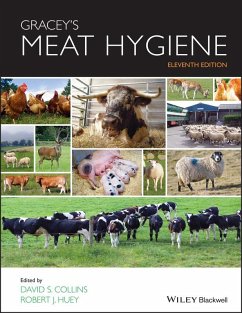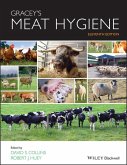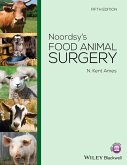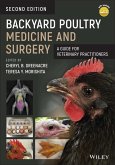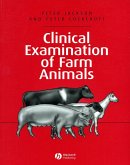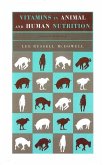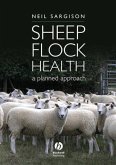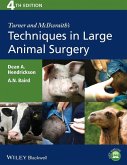Gracey's Meat Hygiene (eBook, PDF)
Redaktion: Collins, David S.; Huey, Robert J.


Alle Infos zum eBook verschenken

Gracey's Meat Hygiene (eBook, PDF)
Redaktion: Collins, David S.; Huey, Robert J.
- Format: PDF
- Merkliste
- Auf die Merkliste
- Bewerten Bewerten
- Teilen
- Produkt teilen
- Produkterinnerung
- Produkterinnerung

Hier können Sie sich einloggen

Bitte loggen Sie sich zunächst in Ihr Kundenkonto ein oder registrieren Sie sich bei bücher.de, um das eBook-Abo tolino select nutzen zu können.
GRACEY'S MEAT HYGIENE Gracey's Meat Hygiene, 11th edition, is the definitive reference for veterinarians working in meat hygiene control. This new edition of a classic text reflects the recent significant changes in science, legislation and practical implementation of meat hygiene controls in the United Kingdom, Europe and worldwide since the 10th edition was published in 1999. This book is an excellent practical guide for teaching food hygiene to veterinary students worldwide, laying the foundations of food animal anatomy, the humane slaughter of animals for food and practical production…mehr
- Geräte: PC
- mit Kopierschutz
- eBook Hilfe
- Größe: 20.92MB
![Gracey's Meat Hygiene (eBook, ePUB) Gracey's Meat Hygiene (eBook, ePUB)]() Gracey's Meat Hygiene (eBook, ePUB)105,99 €
Gracey's Meat Hygiene (eBook, ePUB)105,99 €![Noordsy's Food Animal Surgery (eBook, PDF) Noordsy's Food Animal Surgery (eBook, PDF)]() N. Kent AmesNoordsy's Food Animal Surgery (eBook, PDF)94,99 €
N. Kent AmesNoordsy's Food Animal Surgery (eBook, PDF)94,99 €![Backyard Poultry Medicine and Surgery (eBook, PDF) Backyard Poultry Medicine and Surgery (eBook, PDF)]() Backyard Poultry Medicine and Surgery (eBook, PDF)97,99 €
Backyard Poultry Medicine and Surgery (eBook, PDF)97,99 €![Clinical Examination of Farm Animals (eBook, PDF) Clinical Examination of Farm Animals (eBook, PDF)]() Peter JacksonClinical Examination of Farm Animals (eBook, PDF)97,99 €
Peter JacksonClinical Examination of Farm Animals (eBook, PDF)97,99 €![Vitamins in Animal and Human Nutrition (eBook, PDF) Vitamins in Animal and Human Nutrition (eBook, PDF)]() Lee Russell McDowellVitamins in Animal and Human Nutrition (eBook, PDF)156,99 €
Lee Russell McDowellVitamins in Animal and Human Nutrition (eBook, PDF)156,99 €![Sheep Flock Health (eBook, PDF) Sheep Flock Health (eBook, PDF)]() Neil SargisonSheep Flock Health (eBook, PDF)95,99 €
Neil SargisonSheep Flock Health (eBook, PDF)95,99 €![Turner and McIlwraith's Techniques in Large Animal Surgery (eBook, PDF) Turner and McIlwraith's Techniques in Large Animal Surgery (eBook, PDF)]() Dean A. HendricksonTurner and McIlwraith's Techniques in Large Animal Surgery (eBook, PDF)107,99 €
Dean A. HendricksonTurner and McIlwraith's Techniques in Large Animal Surgery (eBook, PDF)107,99 €-
-
-
Dieser Download kann aus rechtlichen Gründen nur mit Rechnungsadresse in A, B, BG, CY, CZ, D, DK, EW, E, FIN, F, GR, HR, H, IRL, I, LT, L, LR, M, NL, PL, P, R, S, SLO, SK ausgeliefert werden.
- Produktdetails
- Verlag: John Wiley & Sons
- Seitenzahl: 352
- Erscheinungstermin: 17. November 2014
- Englisch
- ISBN-13: 9781118650004
- Artikelnr.: 41838633
- Verlag: John Wiley & Sons
- Seitenzahl: 352
- Erscheinungstermin: 17. November 2014
- Englisch
- ISBN-13: 9781118650004
- Artikelnr.: 41838633
- Herstellerkennzeichnung Die Herstellerinformationen sind derzeit nicht verfügbar.
Preface xiii
Acknowledgements xv
1 The food animals 1
Dietary factors 2
World livestock production 3
UK meat plants and throughputs 4
Cattle 4
Breeds 4
Systems of beef production 6
Growth promoters 7
Definitions 7
Sheep 7
Definitions 9
Pigs 10
Pig breeds 10
Pig breeds in the United Kingdom 11
Pig production 11
Pig meat production 13
Glossary of terms 13
Additional facts 13
Goats 13
Poultry 14
Definitions 14
Rabbits 15
Deer 16
Handling of deer 17
References 17
Further reading 17
Form animal welfare council 17
2 Anatomy 19
Descriptive terms 19
Osteology and arthrology 19
Bones 19
Digestive system 21
Tongue 21
Stomach 22
Mucous membranes 22
Intestines 23
Liver 24
Pancreas (gut sweetbread) 25
Respiratory system 26
Lungs 26
Pluck 26
Circulatory system (heart, arteries, capillaries and veins) 26
Heart 26
Portal circulation 27
Spleen (melt) 27
Lymphatic system 28
Haemal lymph nodes 28
Lymph nodes of the ox 29
Nodes of the head and neck 30
Nodes of the chest and forequarter 30
Nodes of the abdomen and hindquarter 31
Lymph nodes of the pig 33
Head and neck 33
Other nodes 33
Urogenital system 34
Urinary organs 34
Genital organs 34
Kidney 34
Reproductive system 34
Uterus 34
Udder 36
Endocrine system 36
Thymus 36
Adrenal (suprarenal) bodies 36
Testicles (testes) 37
Collection and yield of glands 37
Skin 37
Horns 37
Muscular system 37
Connective tissue 38
Fat 38
Determination of age by dentition 38
Teeth 38
Determination of sex 39
Cattle 39
Sheep 40
Pigs 41
Horse and ox differentiation 41
Debasement of food
(adulteration and substitution) 41
Food tampering 43
References 43
Further reading 43
3 Meat establishment construction and equipment 45
Site 45
Environmental statement 45
Submission of plans 46
Area size 46
Facilities 47
Equipment design 50
Pest control 51
Small abattoir units 51
Lairage 52
Cattle lairage 52
Sheep lairage 52
Pig lairage 52
Deer lairage 53
Clipping or cleaning of livestock 53
Manure disposal 53
Slaughterhall 53
Stunning area 53
Bleeding area 54
Cattle carcase dressing 54
On-the-rail dressing 55
Sheep slaughterhall 56
Pig slaughterhall 57
Singeing and scraping 58
Refrigeration accommodation 58
Detained meat room 59
Condemned meat room 60
Hide and skin store 60
Gut and tripe room 60
Red offal room 60
The edible fat room 61
Cutting rooms 61
Equipment wash 61
Fresh meat dispatch area 61
Vehicle washing 62
General amenities for personnel 62
Veterinary office 62
Treatment of effluent 62
Pollution parameters 63
Treatment 63
Preliminary treatment: Screening, solids and grit removal 63
Secondary treatment 64
Further reading 65
4 Preservation of meat 67
Physical changes in stored meat 67
Chemical changes in stored meat 68
Water activity or water availability (aw ) 68
Meat curing 68
Salt 68
Ingredients used in curing 69
Production of bacon and ham 69
Cutting 70
Application of the pickle 70
Production of cooked hams 71
Traditional dry-cured bacon 71
Alternative dry cure 71
Smoking 71
Common defects in cured meat 71
Micro-organisms on cured product 72
Refrigeration 72
Mechanical refrigeration 72
Chilling of meat 73
Freezing of meat 75
Freeze-drying or lyophilisation 76
Storage of fresh meat 76
Vacuum packing 76
Modified atmosphere packing 76
Refrigerated meat transport and storage 76
Changes in frozen meat 77
'Weeping' or 'drip' 77
Durability of frozen meat 78
Effect of freezing on pathogenic micro-organisms and parasites 78
Heat: Thermal processing 78
Traditional canning methodology 79
Treatment of food to be canned 79
Canning operations 80
Canning of meats 82
Foods packed in glass 82
Spoilage in canned foods 82
Types of spoilage 83
The public health aspect of canned foods 85
Other methods of meat preservation 86
Antioxidants 86
Preservatives 86
Irradiation 86
Infrared radiation 86
Ultraviolet radiation 86
Ionising radiation 86
High pressure 87
References 87
Further reading 88
5 Plant sanitation 89
Reasons for cleaning and disinfecting plant 89
'Scotoma effect' or 'factory-blindness' 90
The chemistry of cleaning 90
The soil 91
The substrate: Materials of construction 91
Energies of cleaning 92
Chemical and physical reactions of cleaning 92
Detergents: Design and choice 95
Principles of disinfection 95
Biocidal active components 95
Disinfectants: Design and choice 97
Hygiene equipment and application methods 97
Manual cleaning 98
Foam cleaning 98
Foam and disinfectant application equipment 98
Gels 99
Spray 100
Fogging 100
Knife and cutting tool disinfection during processing 100
Machine washing 102
Cleaning-in-place (CIP) 102
Rinse systems 104
Contamination and re-contamination 105
Air 105
Water 106
People 106
Surfaces 106
Cleaning procedures 106
The cleaning sequence 106
Monitoring of hygiene 108
Training 110
Safety 110
Effluent and external odour control 110
Conclusion 111
Note 111
References 112
6 From farm to slaughter 113
Production of clean, healthy livestock 113
Clean livestock 115
Healthy livestock 117
Safe use of animal medicines 117
Safe disposal of animal waste 117
Animal welfare on the farm 119
Assessment of an animal's welfare 119
Transportation of livestock 122
Loading and unloading 122
The journey to slaughter 123
EU transport legislation 123
Protection during transport 123
Means of transport 123
Space allowances 123
Duties of transporters 123
Feed, water and rest periods 123
Treatment of sick animals 124
Travel documentation 124
Loss of weight during transport 124
Transport mortality 125
Lairage construction 126
Animal husbandry in the lairage 127
Moving animals within the lairage 127
Social stress 128
Watering 128
Fasting 128
Resting of animals prior to slaughter 129
Pre-slaughter handling and meat quality 129
Stress and the animal 129
Stress and meat quality 130
Pre-slaughter feeding of sugars 131
Traumatic injury 131
Time of bruising 131
Rough handling 132
Presence of horns 132
Temperament 132
Stunning box design 132
Mixing of animals 133
Breed 133
Incentives and education 133
References 133
Further reading 134
7 Humane slaughter 135
Pre-slaughter handling/restraint 136
Cattle movement and restraint 136
Pig movement and restraint 137
The slaughtering process 137
Assessment of unconsciousness at
slaughter 137
Methods of stunning 138
Percussive stunning 138
Head sites for percussive stunning 140
Water jet stunning 142
Carbon dioxide and other gas mixtures 142
Electrical stunning 144
Effect of stunning on meat quality 146
Slaughter of minor species 146
Slaughter of deer 146
Slaughter of ostriches 147
Slaughter of rabbits 147
Other methods of slaughter 147
Slaughter of poultry 148
Electrical stunning of poultry 148
Assessment of unconsciousness in
electrical water bath stunned poultry 149
Stunning/killing poultry with controlled atmospheres 149
Percussive stunning of poultry 150
Other methods of slaughter 150
Effects of stunning on poultry meat quality 150
Pithing 150
Bleeding 151
Cattle 151
Sheep 151
Pigs 152
Efficiency of bleeding 153
Slaughter without pre-stunning 153
Shechita - Jewish religious slaughter 153
Muslim methods of slaughter 156
Slaughter of poultry without stunning 157
References 157
Further reading 158
8 Meat hygiene practice 159
Meat and animal by-products 159
Hygienic production 159
Sources of contamination 159
Outer integument - hide, hair, fleece or skin 159
Gastrointestinal tract 160
Stunning and sticking 160
Physical contact with structures 160
Operatives 160
Equipment and utensils 161
The slaughter hall environment 161
Vermin and pests 161
Chemical contamination 162
Methods of reducing contamination 162
Dealing with the dirty animal 162
Clipping cattle on line 163
Protecting the meat from the worker 163
Good hygiene practice 165
Layout and flow lines 167
Dressing techniques - Removal of hide/fleece/hair 167
Preventing contamination from the gastrointestinal tract 170
Post-slaughter decontamination 172
Water 172
Trimming 173
Chemical treatments 173
Bacteriophages 174
Ultraviolet and pulsed high-intensity light 174
Outputs of the slaughterhouse 174
Treatment of edible co-products 175
Fats 175
Edible fat rendering 176
Stomach and intestines 176
Bones 177
Hides and skins 177
Animal by-products 178
Category 1 178
Category 2 179
Category 3 (can be used for pet food) 180
Materials for technical uses 181
Hygiene requirements for animal by-product processing establishments 183
Rendering processes 183
References 184
9 Meat inspection protocols 185
The case for change 185
The holistic approach 187
Integrated Food Safety Assurance 187
Farm to fork 187
Food chain information 187
Ante-mortem inspection 188
Ante-mortem inspection procedure in the slaughter establishment 189
Practical ante-mortem procedure 190
Emergency slaughter animals 191
Emergency slaughter: The decision on farm 191
Emergency slaughter: The decision
at the slaughter establishment 192
Post-mortem inspection 192
Facilities for post-mortem inspection 192
Carcase identification and traceability 193
Traditional post-mortem inspection 194
Traditional post-mortem inspection of cattle 194
Traditional post-mortem inspection of calves 196
Traditional post-mortem inspection of sheep and goats 196
Traditional post-mortem inspection of pigs 196
Traditional post-mortem inspection of equines 197
Traditional post-mortem inspection of poultry 197
Decisions at post-mortem examination 198
Common post-mortem findings 203
Abscesses 203
Omphalophlebitis 204
Arthritis 204
Oedema 204
Pneumonia and pleurisy 205
Endocarditis 206
Pericarditis 207
Pyelonephritis 207
Bruising 208
Pigmentation 208
Haematogenous pigments 209
Bile pigments 209
Porphyrin 210
Lipofuscin ('wear-and-tear pigment', pigment of brown atrophy, lipochrome,
haemofuscin) 211
Xanthosis (xanthomatosis, osteohaematochromatosis, brown atrophy) 211
Tumours 211
Classes of tumours 212
Causes of tumours 212
Effect on host 212
Nomenclature of neoplasms 212
Judgement of neoplasia 213
Poor condition/emaciation 213
Contamination 215
Parasitic conditions 215
Ascaris suum 215
Echinococcus granulosus: Hydatidosis and hydatid cyst 215
Taenia hydatigena (known as Cysticercus tenuicollis in larval stage) 216
Taenia ovis (previously known as Cysticercus ovis) 216
Fasciola hepatica: Liver fluke 216
Paramphistomiasis 216
Sarcocystis 216
Courses of action 217
Utilisation of post-mortem data 218
Control of hygienic production 218
Hazard analysis and critical control points (HACCP) 219
Implementation of an HACCP system 219
Worldwide food safety standards 221
References 222
Further reading 222
10 Poultry production, slaughter and inspection 223
Production of poultry 223
Poultry feedingstuffs 225
Poultry flock health 226
Catching and crating 226
Reception and unloading 227
Pre-slaughter inspection 228
Shackling 228
Stunning and slaughter 229
Scalding and defeathering 230
Defeathering 231
Evisceration 232
Chilling 235
Ante-mortem health inspection 237
Post-mortem inspection in the plant 240
Decision of the official veterinarian at the post-mortem inspection 241
General contamination 242
Guidelines on trimming poultry 242
Coliform infections 243
Salmonellosis 243
Campylobacteriosis 244
Chlamydiosis (psittacosis/ornithosis) 245
Miscellaneous conditions 245
Dead on arrival 245
Bruising and fractures 245
Breast blisters and hock burn 246
Ascites 246
Slaughter liver or cholangiohepatitis 246
Fatty liver haemorrhagic syndrome (FLHS) 246
Vices 246
Contamination 247
Decomposition 247
Barking 247
Diseases of the female reproductive system 247
Oregon disease 247
Over-scald 247
Fevered carcases 247
Septicaemia 247
Insufficient bleeding 247
Emaciation 247
Viscera absent 247
References 248
Further reading 248
11 Exotic meat production 249
Rabbits 249
Slaughter 249
Inspection 250
Post-mortem judgements in rabbit meat inspection 250
Zoonoses 251
Guidelines on contamination, missing viscera and trimming 252
Farmed deer 252
Handling and slaughter 252
Park deer 254
Wild deer 254
Killing 254
Ostriches 255
Restraint 256
Stunning 256
Dressing 256
Changes after slaughter 257
Commercial squab production 257
Further reading 257
12 Food poisoning and meat microbiology 259
Part 1: Food poisoning 259
Types of food poisoning 259
Surveillance of food poisoning 259
Laboratory reports of enteric infections 260
Outbreak surveillance 261
General considerations 261
Food-borne pathogens 261
Part 2: Meat microbiology 267
Bacteriological examination of carcases 267
Part 3: Meat decomposition and spoilage 271
Assessment of decomposition 277
Further reading 278
13 Controls on veterinary drug residues in the European Union 279
Legal framework 279
Licensed veterinary medicines 279
Hormones and ß-Agonists 280
Prohibited compounds 280
Unauthorised and unlicensed compounds 281
Regulatory limits: MRLs, MRPLs and RPAs 281
The National Residue Control Plan in EU member states 282
Compound groups 282
Sampling levels for each species 282
Relationship between species and substance to be analysed 283
Testing procedures and performance characteristics 284
Testing procedures 284
CC¿ and CCß 285
Sampling of imported food 285
Legal basis for sampling of imports from third countries 285
Frequency of sampling of imports from third countries 285
Interpretation of non-compliant results 285
The Rapid Alert System for Food and Feed (RASFF) 285
Legal basis and description of the RASFF 285
RASFF notification types 286
Notification basis 286
Action taken 286
Distribution status 286
Actions taken following infringements 286
Analytical methods: Technical aspects 287
Method specificity 287
Performance characteristics 288
Method validation 288
Proficiency testing 289
References 289
14 Health and safety in meat processing 291
Accident statistics 291
UK legislation 291
General duties 292
Key topics requiring risk assessment 293
Being struck by hand tools
including knives 293
Musculoskeletal disorders 294
Slips, trips and falls 298
Contact with machinery 298
Transport 301
Falls from a height 301
Substances/microorganisms 302
Zoonoses 303
Specific control measures for zoonoses 303
Animals 310
Noise 310
Cold environment 311
General requirements 312
References 316
Index 319
Preface xiii
Acknowledgements xv
1 The food animals 1
Dietary factors 2
World livestock production 3
UK meat plants and throughputs 4
Cattle 4
Breeds 4
Systems of beef production 6
Growth promoters 7
Definitions 7
Sheep 7
Definitions 9
Pigs 10
Pig breeds 10
Pig breeds in the United Kingdom 11
Pig production 11
Pig meat production 13
Glossary of terms 13
Additional facts 13
Goats 13
Poultry 14
Definitions 14
Rabbits 15
Deer 16
Handling of deer 17
References 17
Further reading 17
Form animal welfare council 17
2 Anatomy 19
Descriptive terms 19
Osteology and arthrology 19
Bones 19
Digestive system 21
Tongue 21
Stomach 22
Mucous membranes 22
Intestines 23
Liver 24
Pancreas (gut sweetbread) 25
Respiratory system 26
Lungs 26
Pluck 26
Circulatory system (heart, arteries, capillaries and veins) 26
Heart 26
Portal circulation 27
Spleen (melt) 27
Lymphatic system 28
Haemal lymph nodes 28
Lymph nodes of the ox 29
Nodes of the head and neck 30
Nodes of the chest and forequarter 30
Nodes of the abdomen and hindquarter 31
Lymph nodes of the pig 33
Head and neck 33
Other nodes 33
Urogenital system 34
Urinary organs 34
Genital organs 34
Kidney 34
Reproductive system 34
Uterus 34
Udder 36
Endocrine system 36
Thymus 36
Adrenal (suprarenal) bodies 36
Testicles (testes) 37
Collection and yield of glands 37
Skin 37
Horns 37
Muscular system 37
Connective tissue 38
Fat 38
Determination of age by dentition 38
Teeth 38
Determination of sex 39
Cattle 39
Sheep 40
Pigs 41
Horse and ox differentiation 41
Debasement of food
(adulteration and substitution) 41
Food tampering 43
References 43
Further reading 43
3 Meat establishment construction and equipment 45
Site 45
Environmental statement 45
Submission of plans 46
Area size 46
Facilities 47
Equipment design 50
Pest control 51
Small abattoir units 51
Lairage 52
Cattle lairage 52
Sheep lairage 52
Pig lairage 52
Deer lairage 53
Clipping or cleaning of livestock 53
Manure disposal 53
Slaughterhall 53
Stunning area 53
Bleeding area 54
Cattle carcase dressing 54
On-the-rail dressing 55
Sheep slaughterhall 56
Pig slaughterhall 57
Singeing and scraping 58
Refrigeration accommodation 58
Detained meat room 59
Condemned meat room 60
Hide and skin store 60
Gut and tripe room 60
Red offal room 60
The edible fat room 61
Cutting rooms 61
Equipment wash 61
Fresh meat dispatch area 61
Vehicle washing 62
General amenities for personnel 62
Veterinary office 62
Treatment of effluent 62
Pollution parameters 63
Treatment 63
Preliminary treatment: Screening, solids and grit removal 63
Secondary treatment 64
Further reading 65
4 Preservation of meat 67
Physical changes in stored meat 67
Chemical changes in stored meat 68
Water activity or water availability (aw ) 68
Meat curing 68
Salt 68
Ingredients used in curing 69
Production of bacon and ham 69
Cutting 70
Application of the pickle 70
Production of cooked hams 71
Traditional dry-cured bacon 71
Alternative dry cure 71
Smoking 71
Common defects in cured meat 71
Micro-organisms on cured product 72
Refrigeration 72
Mechanical refrigeration 72
Chilling of meat 73
Freezing of meat 75
Freeze-drying or lyophilisation 76
Storage of fresh meat 76
Vacuum packing 76
Modified atmosphere packing 76
Refrigerated meat transport and storage 76
Changes in frozen meat 77
'Weeping' or 'drip' 77
Durability of frozen meat 78
Effect of freezing on pathogenic micro-organisms and parasites 78
Heat: Thermal processing 78
Traditional canning methodology 79
Treatment of food to be canned 79
Canning operations 80
Canning of meats 82
Foods packed in glass 82
Spoilage in canned foods 82
Types of spoilage 83
The public health aspect of canned foods 85
Other methods of meat preservation 86
Antioxidants 86
Preservatives 86
Irradiation 86
Infrared radiation 86
Ultraviolet radiation 86
Ionising radiation 86
High pressure 87
References 87
Further reading 88
5 Plant sanitation 89
Reasons for cleaning and disinfecting plant 89
'Scotoma effect' or 'factory-blindness' 90
The chemistry of cleaning 90
The soil 91
The substrate: Materials of construction 91
Energies of cleaning 92
Chemical and physical reactions of cleaning 92
Detergents: Design and choice 95
Principles of disinfection 95
Biocidal active components 95
Disinfectants: Design and choice 97
Hygiene equipment and application methods 97
Manual cleaning 98
Foam cleaning 98
Foam and disinfectant application equipment 98
Gels 99
Spray 100
Fogging 100
Knife and cutting tool disinfection during processing 100
Machine washing 102
Cleaning-in-place (CIP) 102
Rinse systems 104
Contamination and re-contamination 105
Air 105
Water 106
People 106
Surfaces 106
Cleaning procedures 106
The cleaning sequence 106
Monitoring of hygiene 108
Training 110
Safety 110
Effluent and external odour control 110
Conclusion 111
Note 111
References 112
6 From farm to slaughter 113
Production of clean, healthy livestock 113
Clean livestock 115
Healthy livestock 117
Safe use of animal medicines 117
Safe disposal of animal waste 117
Animal welfare on the farm 119
Assessment of an animal's welfare 119
Transportation of livestock 122
Loading and unloading 122
The journey to slaughter 123
EU transport legislation 123
Protection during transport 123
Means of transport 123
Space allowances 123
Duties of transporters 123
Feed, water and rest periods 123
Treatment of sick animals 124
Travel documentation 124
Loss of weight during transport 124
Transport mortality 125
Lairage construction 126
Animal husbandry in the lairage 127
Moving animals within the lairage 127
Social stress 128
Watering 128
Fasting 128
Resting of animals prior to slaughter 129
Pre-slaughter handling and meat quality 129
Stress and the animal 129
Stress and meat quality 130
Pre-slaughter feeding of sugars 131
Traumatic injury 131
Time of bruising 131
Rough handling 132
Presence of horns 132
Temperament 132
Stunning box design 132
Mixing of animals 133
Breed 133
Incentives and education 133
References 133
Further reading 134
7 Humane slaughter 135
Pre-slaughter handling/restraint 136
Cattle movement and restraint 136
Pig movement and restraint 137
The slaughtering process 137
Assessment of unconsciousness at
slaughter 137
Methods of stunning 138
Percussive stunning 138
Head sites for percussive stunning 140
Water jet stunning 142
Carbon dioxide and other gas mixtures 142
Electrical stunning 144
Effect of stunning on meat quality 146
Slaughter of minor species 146
Slaughter of deer 146
Slaughter of ostriches 147
Slaughter of rabbits 147
Other methods of slaughter 147
Slaughter of poultry 148
Electrical stunning of poultry 148
Assessment of unconsciousness in
electrical water bath stunned poultry 149
Stunning/killing poultry with controlled atmospheres 149
Percussive stunning of poultry 150
Other methods of slaughter 150
Effects of stunning on poultry meat quality 150
Pithing 150
Bleeding 151
Cattle 151
Sheep 151
Pigs 152
Efficiency of bleeding 153
Slaughter without pre-stunning 153
Shechita - Jewish religious slaughter 153
Muslim methods of slaughter 156
Slaughter of poultry without stunning 157
References 157
Further reading 158
8 Meat hygiene practice 159
Meat and animal by-products 159
Hygienic production 159
Sources of contamination 159
Outer integument - hide, hair, fleece or skin 159
Gastrointestinal tract 160
Stunning and sticking 160
Physical contact with structures 160
Operatives 160
Equipment and utensils 161
The slaughter hall environment 161
Vermin and pests 161
Chemical contamination 162
Methods of reducing contamination 162
Dealing with the dirty animal 162
Clipping cattle on line 163
Protecting the meat from the worker 163
Good hygiene practice 165
Layout and flow lines 167
Dressing techniques - Removal of hide/fleece/hair 167
Preventing contamination from the gastrointestinal tract 170
Post-slaughter decontamination 172
Water 172
Trimming 173
Chemical treatments 173
Bacteriophages 174
Ultraviolet and pulsed high-intensity light 174
Outputs of the slaughterhouse 174
Treatment of edible co-products 175
Fats 175
Edible fat rendering 176
Stomach and intestines 176
Bones 177
Hides and skins 177
Animal by-products 178
Category 1 178
Category 2 179
Category 3 (can be used for pet food) 180
Materials for technical uses 181
Hygiene requirements for animal by-product processing establishments 183
Rendering processes 183
References 184
9 Meat inspection protocols 185
The case for change 185
The holistic approach 187
Integrated Food Safety Assurance 187
Farm to fork 187
Food chain information 187
Ante-mortem inspection 188
Ante-mortem inspection procedure in the slaughter establishment 189
Practical ante-mortem procedure 190
Emergency slaughter animals 191
Emergency slaughter: The decision on farm 191
Emergency slaughter: The decision
at the slaughter establishment 192
Post-mortem inspection 192
Facilities for post-mortem inspection 192
Carcase identification and traceability 193
Traditional post-mortem inspection 194
Traditional post-mortem inspection of cattle 194
Traditional post-mortem inspection of calves 196
Traditional post-mortem inspection of sheep and goats 196
Traditional post-mortem inspection of pigs 196
Traditional post-mortem inspection of equines 197
Traditional post-mortem inspection of poultry 197
Decisions at post-mortem examination 198
Common post-mortem findings 203
Abscesses 203
Omphalophlebitis 204
Arthritis 204
Oedema 204
Pneumonia and pleurisy 205
Endocarditis 206
Pericarditis 207
Pyelonephritis 207
Bruising 208
Pigmentation 208
Haematogenous pigments 209
Bile pigments 209
Porphyrin 210
Lipofuscin ('wear-and-tear pigment', pigment of brown atrophy, lipochrome,
haemofuscin) 211
Xanthosis (xanthomatosis, osteohaematochromatosis, brown atrophy) 211
Tumours 211
Classes of tumours 212
Causes of tumours 212
Effect on host 212
Nomenclature of neoplasms 212
Judgement of neoplasia 213
Poor condition/emaciation 213
Contamination 215
Parasitic conditions 215
Ascaris suum 215
Echinococcus granulosus: Hydatidosis and hydatid cyst 215
Taenia hydatigena (known as Cysticercus tenuicollis in larval stage) 216
Taenia ovis (previously known as Cysticercus ovis) 216
Fasciola hepatica: Liver fluke 216
Paramphistomiasis 216
Sarcocystis 216
Courses of action 217
Utilisation of post-mortem data 218
Control of hygienic production 218
Hazard analysis and critical control points (HACCP) 219
Implementation of an HACCP system 219
Worldwide food safety standards 221
References 222
Further reading 222
10 Poultry production, slaughter and inspection 223
Production of poultry 223
Poultry feedingstuffs 225
Poultry flock health 226
Catching and crating 226
Reception and unloading 227
Pre-slaughter inspection 228
Shackling 228
Stunning and slaughter 229
Scalding and defeathering 230
Defeathering 231
Evisceration 232
Chilling 235
Ante-mortem health inspection 237
Post-mortem inspection in the plant 240
Decision of the official veterinarian at the post-mortem inspection 241
General contamination 242
Guidelines on trimming poultry 242
Coliform infections 243
Salmonellosis 243
Campylobacteriosis 244
Chlamydiosis (psittacosis/ornithosis) 245
Miscellaneous conditions 245
Dead on arrival 245
Bruising and fractures 245
Breast blisters and hock burn 246
Ascites 246
Slaughter liver or cholangiohepatitis 246
Fatty liver haemorrhagic syndrome (FLHS) 246
Vices 246
Contamination 247
Decomposition 247
Barking 247
Diseases of the female reproductive system 247
Oregon disease 247
Over-scald 247
Fevered carcases 247
Septicaemia 247
Insufficient bleeding 247
Emaciation 247
Viscera absent 247
References 248
Further reading 248
11 Exotic meat production 249
Rabbits 249
Slaughter 249
Inspection 250
Post-mortem judgements in rabbit meat inspection 250
Zoonoses 251
Guidelines on contamination, missing viscera and trimming 252
Farmed deer 252
Handling and slaughter 252
Park deer 254
Wild deer 254
Killing 254
Ostriches 255
Restraint 256
Stunning 256
Dressing 256
Changes after slaughter 257
Commercial squab production 257
Further reading 257
12 Food poisoning and meat microbiology 259
Part 1: Food poisoning 259
Types of food poisoning 259
Surveillance of food poisoning 259
Laboratory reports of enteric infections 260
Outbreak surveillance 261
General considerations 261
Food-borne pathogens 261
Part 2: Meat microbiology 267
Bacteriological examination of carcases 267
Part 3: Meat decomposition and spoilage 271
Assessment of decomposition 277
Further reading 278
13 Controls on veterinary drug residues in the European Union 279
Legal framework 279
Licensed veterinary medicines 279
Hormones and ß-Agonists 280
Prohibited compounds 280
Unauthorised and unlicensed compounds 281
Regulatory limits: MRLs, MRPLs and RPAs 281
The National Residue Control Plan in EU member states 282
Compound groups 282
Sampling levels for each species 282
Relationship between species and substance to be analysed 283
Testing procedures and performance characteristics 284
Testing procedures 284
CC¿ and CCß 285
Sampling of imported food 285
Legal basis for sampling of imports from third countries 285
Frequency of sampling of imports from third countries 285
Interpretation of non-compliant results 285
The Rapid Alert System for Food and Feed (RASFF) 285
Legal basis and description of the RASFF 285
RASFF notification types 286
Notification basis 286
Action taken 286
Distribution status 286
Actions taken following infringements 286
Analytical methods: Technical aspects 287
Method specificity 287
Performance characteristics 288
Method validation 288
Proficiency testing 289
References 289
14 Health and safety in meat processing 291
Accident statistics 291
UK legislation 291
General duties 292
Key topics requiring risk assessment 293
Being struck by hand tools
including knives 293
Musculoskeletal disorders 294
Slips, trips and falls 298
Contact with machinery 298
Transport 301
Falls from a height 301
Substances/microorganisms 302
Zoonoses 303
Specific control measures for zoonoses 303
Animals 310
Noise 310
Cold environment 311
General requirements 312
References 316
Index 319
